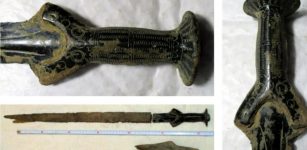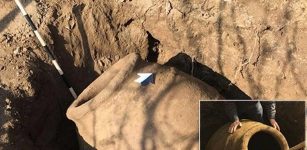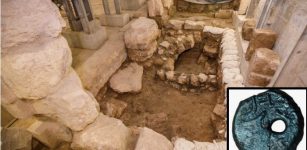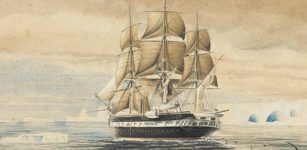Veles And Perun: Most Powerful Slavic Gods In Conflict Between Powers Of Light And Darkness
A. Sutherland - AncientPages.com - Veles represents one of the most important Slavic gods, (another is his own brother and adversary, Perun, God of Heaven and Lightning).
Mentioned in numerous myths and legends of the Slavs especially inhabitants of the Czech Republic, Poland, and Russia, they are both involved in conflicts of powers of Light and Darkness and still, their relationship is of great importance for the planet’s survival.
Veles with a cow's head on his chest on the model of the Millennium of Russia monument. Image credit: shakko - CC BY-SA 3.0
Veles, on the other hand, was a powerful ruler of Nav, the land of the dead, which is a Slavic underworld. It was believed that he had the ability to transform into a snake, and was a guardian to the underworld.
In the underworld, Veles was a shepherd of human souls, but like many other deities of the Slavic pantheon, he was multifunctional. Different aspects of this mythological figure deeply influenced the beliefs of ancient Slavs.
In some myths and legends, as a god of peasants and a chief guardian of cattle, Veles had abilities to effectively protect the herd from wild animals, especially wolves. In ancient times, people used to make offerings to Veles, in form of the last bunch of ears, which was called the “Veles beard”.
He usually appeared as an old man with a long gray beard, but sometimes also as a black goat. It was believed that he lived in the center of the inaccessible wetland located in the underground realm of the dead and his throne was at the root of the sacred tree.
People swore by his name because he was also a god of law and oaths, art and craft, but at the same time, he practiced magic, trickery, foretelling, and supernatural phenomena. He also punishes oath-breakers with diseases, while his brother, god Perun, a ruling god of war, punishes by death in battle.
Veles has been always considered to be a complex mythological figure especially regarding his origin and the role he played in the ancient beliefs of the Slavs. Many different and contradicting features of this enigmatic deity, show his significance and meaning in the pantheon.
Veles is a very charismatic god but so is his brother and eternal opponent, Perun, the supreme god of the Slavic Pantheon as well.
M. Priesniakow (1998). Perun. Image credit: Max presnyakov - CC BY-SA 3.0
The god’s name “Perun” is associated with thunder (in Polish: piorun) and other attributes such as hail, rain, honor, masculinity, mountain, horse, fire, stone, and later metal weapons (hammer, ax, arrow).
His other attribute of great importance is oak, which is widely regarded as the sacred Slavic tree - the focal point of the axis mundi - the axis of the world.
The Slavic oak represents the connection between Heaven and Earth like Yggdrasil in Norse mythology and Ceiba Tree of Maya.
The concept is universal and adopted by religions and cosmologies of many cultures around the world.
Perun and Veles are two of the most important gods in the Slavic pantheon. Perun represents the skies, and Veles represents earth.
These gods are so extremely different that they contradict each other and participate in a never-ending battle. Perun wields his ax from the skies and shoots powerful thunderbolts to the earth, where Veles lives usually in the form of a dragon/snake, and steals Perun’s possession.
One myth mentions Veles steals Jarilo, a son of Perun from the cradle, and brings him to the underworld. Veles raises him as his son. In the springtime, Jarilo returns from the land of the dead, (according to the Slavic beliefs is located beyond the sea) and brings spring from the ever-green underworld into the realm of the living.
The problem is that Jarilo, the god of fertility, vegetation, and spring must be stolen. If this event does not happen, no spring season arises on earth. The battle between Veles and Perun is hopeless because it can never end; these two gods can never meet; heaven and earth are meant to be apart forever and never touch each other.
This conflict will never cease.
Written by – A. Sutherland AncientPages.com Staff Writer
Copyright © AncientPages.com All rights reserved. This material may not be published, broadcast, rewritten or redistributed in whole or part without the express written permission of AncientPages.com
More From Ancient Pages
-
 Rare 3,300-Year-Old Sword Accidentally Discovered In Jesenicko, Czech Republic
Archaeology | Nov 9, 2020
Rare 3,300-Year-Old Sword Accidentally Discovered In Jesenicko, Czech Republic
Archaeology | Nov 9, 2020 -
 Early Homo Sapiens From Southeast Asia Could Adapt To A Rainforest Environment
Archaeology | Oct 17, 2021
Early Homo Sapiens From Southeast Asia Could Adapt To A Rainforest Environment
Archaeology | Oct 17, 2021 -
 Atlatl Weapon Use By Prehistoric Females Equalized The Division Of Labor While Hunting – Study Shows
Archaeology | Aug 18, 2023
Atlatl Weapon Use By Prehistoric Females Equalized The Division Of Labor While Hunting – Study Shows
Archaeology | Aug 18, 2023 -
 Unexpected Neanderthal Behavior In Spain’s Southern Pyrenees – Revealed
Archaeology | Aug 14, 2024
Unexpected Neanderthal Behavior In Spain’s Southern Pyrenees – Revealed
Archaeology | Aug 14, 2024 -
 Never-Before-Seen Ancient Frescoes Discovered Inside The Dormition Cathedral
Archaeology | Feb 28, 2020
Never-Before-Seen Ancient Frescoes Discovered Inside The Dormition Cathedral
Archaeology | Feb 28, 2020 -
 Why Is Roulette Called The Devil’s Game?
Ancient History Facts | Apr 3, 2018
Why Is Roulette Called The Devil’s Game?
Ancient History Facts | Apr 3, 2018 -
 Invention Of Ancient Military Technologies Throughout World History Investigated
Archaeology | Oct 23, 2021
Invention Of Ancient Military Technologies Throughout World History Investigated
Archaeology | Oct 23, 2021 -
 Unsolved Prehistoric Enigma Of Sophisticated Spiro People And Their Mysterious Mounds
Civilizations | Oct 25, 2018
Unsolved Prehistoric Enigma Of Sophisticated Spiro People And Their Mysterious Mounds
Civilizations | Oct 25, 2018 -
 Old Royal Crime – Dark Riddle Of Young Princes In The Tower Of London
Featured Stories | Jun 14, 2020
Old Royal Crime – Dark Riddle Of Young Princes In The Tower Of London
Featured Stories | Jun 14, 2020 -
 2,000-Year-Old Huge Terracotta Jar Discovered In Turkey
Archaeology | Jan 2, 2018
2,000-Year-Old Huge Terracotta Jar Discovered In Turkey
Archaeology | Jan 2, 2018 -
 Study Of Environmental Conditions Of Early Humans In Europe And The Out-Of-Africa Migration
Archaeology | Sep 8, 2021
Study Of Environmental Conditions Of Early Humans In Europe And The Out-Of-Africa Migration
Archaeology | Sep 8, 2021 -
 Ancient Mystery Of Peculiar Nail With Six Faces And Six Eyes – Unusual Discovery In Borgholm Castle, Sweden
Artifacts | Jan 8, 2017
Ancient Mystery Of Peculiar Nail With Six Faces And Six Eyes – Unusual Discovery In Borgholm Castle, Sweden
Artifacts | Jan 8, 2017 -
 Evidence Of The Moon-Eyed People – More Clues – Part 2
Ancient Mysteries | Dec 29, 2019
Evidence Of The Moon-Eyed People – More Clues – Part 2
Ancient Mysteries | Dec 29, 2019 -
 New Evidence Of The Destruction Of The Second Temple In The City Of David
Archaeology | Aug 5, 2023
New Evidence Of The Destruction Of The Second Temple In The City Of David
Archaeology | Aug 5, 2023 -
 On This Day In History: HMS Challenger Begins Scientific Exploration Of Oceans – On Dec 21, 1872
News | Dec 21, 2016
On This Day In History: HMS Challenger Begins Scientific Exploration Of Oceans – On Dec 21, 1872
News | Dec 21, 2016 -
 Beautiful Viking Uig Chessmen Recreated In 3D Images
Archaeology | Sep 17, 2019
Beautiful Viking Uig Chessmen Recreated In 3D Images
Archaeology | Sep 17, 2019 -
 Frigg: Chief Norse Goddess Who Knew Secrets Of Humans’ Fates
Featured Stories | Dec 13, 2022
Frigg: Chief Norse Goddess Who Knew Secrets Of Humans’ Fates
Featured Stories | Dec 13, 2022 -
 What Happened To The Mysterious And Beautiful Queen Nefertiti?
Featured Stories | Apr 4, 2017
What Happened To The Mysterious And Beautiful Queen Nefertiti?
Featured Stories | Apr 4, 2017 -
 Flying Objects Were Present In Ancient Skies
Ancient Mysteries | May 9, 2014
Flying Objects Were Present In Ancient Skies
Ancient Mysteries | May 9, 2014 -
 Greco-Roman Bath Complex, Coin Depicting King Ptolemy III And Other Artifacts Found In Egypt’s Gharbia Province
Archaeology | May 26, 2018
Greco-Roman Bath Complex, Coin Depicting King Ptolemy III And Other Artifacts Found In Egypt’s Gharbia Province
Archaeology | May 26, 2018


